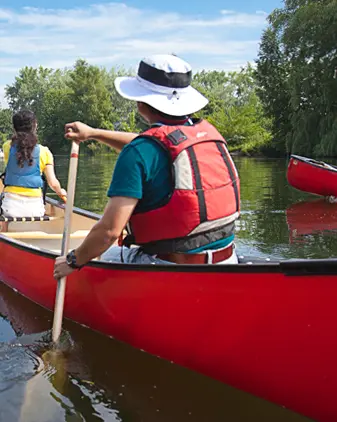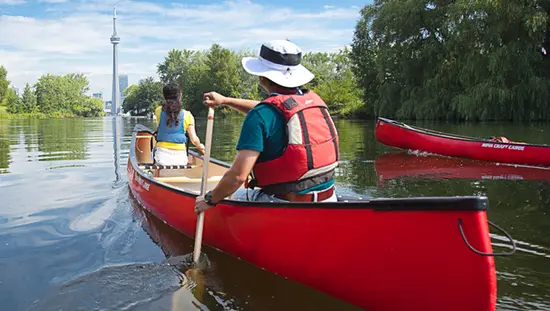Canadian Canoe Museum
Located on the shore of Little Lake, the Canadian Canoe Museum boasts the largest collection of paddled watercrafts in the world. The museum is dedicated to preserving and sharing the culture and history of the canoe.
Canoes were originally created by Indigenous people to navigate lakes and rivers across the continent. The Canadian Canoe Museum was recognized for its cultural importance by the Canadian Senate in 2013. Its state-of-the-art facilities surrounded by nature and an impressive collection and interactive exhibits, help connect visitors to Canada’s rich canoe heritage.
Canadian Canoe Museum | Justen Soule
How to get to Canadian Canoe Museum
Location: 2077 Ashburnham Drive, Peterborough
By car: The Canadian Canoe Museum is located 90 minutes east of Toronto in Peterborough. It can be reached via the ON-115 North, the ON-69 South or the Trans-Canada Highway. Free parking is available on-site and at nearby lots.
By transit: GO Transit offers service between Toronto and Oshawa. GO Transit Bus 88 travels between Durham Collage Oshawa GO and Trent University in Peterborough.
During the summer and fall, the Canoe Bus is a round-trip coach service from Toronto to the museum.
Know before you go
Canadian Canoe Museum is open daily from 10:00 a.m. to 5:00 p.m. On Thursdays, the museum closes at 8:00 p.m.
Admission tickets can be purchased in person or online.
If you’re renting a canoe or kayak or participating in a Voyage Canoe group tour, you must always wear a personal flotation device on the water.
Things to do at Canadian Canoe Museum
Discover more activities and experiences.
View historical canoes
Tour the museum’s expansive collection, which includes skin-on-frame kayaks from Baffin Island, bark canoes from Newfoundland and watercraft from Paraguay and the Amazon.
Join canoe workshops
Learn about canoe construction, build your own birch bark canoe, or plan a prospective canoeing expedition in an immersive workshop.
Paddle on Little Lake
Join a guided group tour with Voyageur Canoe Tours, rent a canoe or kayak or bring your own boat for a paddle.
Paddling for kids and youth
Certified canoe guides help youth connect with tranquil nature at day camps spent paddling or canoe trip expeditions in provincial parks.
Take a canoeing course
Refine your paddling skills and earn a canoe certification from skilled instructors.
Buy canoe-themed gifts
Shop for canoe-inspired items at the Canadian Canoe Museum Store. This curated collection features clothing, books and unique creations by local, Canadian and Indigenous artists.
Articles and itineraries
Get ideas and inspiration for your next trip.

Interesting facts about the Canadian Canoe Museum
With over 600 canoes, kayaks and other paddled watercraft, and over 1,000 related artifacts, this museum’s collection is one of a kind. Items in the collection hail from around the country, coast to coast.
It grew out of Professor Kirk Wipper’s personal collection and was originally founded as the Kanawa Museum in 1957. The museum took on its new name in 1997 and has been presenting this unique take on Canada’s cultural heritage ever since.
Accessibility Features
Ramps
An inclined plane that allows wheelchair users and others to access buildings and navigate between different levels.
Wide doorways and hallways
A sufficiently wide, hard-surfaced, unobstructed path to allow for easy travel.
Automatic doors
Main entrance doors and other accessible entrances and exits are power assisted to allow easy access.
Elevator access
Elevators should be designed to be usable independently by and accessible to persons using wheelchairs, scooters, walkers, canes or crutches, to enter and exit all public facilities. Controls/buttons should include tactile information to ensure easy use by persons who have visual limitations. Controls/buttons should be easy to reach and push, be raised and require minimal strength to activate.
Accessible restaurant
Designed to be accessible to persons with varying disabilities, including those using mobility aids. They include an accessible entrance, adequate maneuvering space, nearby accessible washrooms, tables with removable chairs and sufficient knee clearance, menus in alternate formats, and cafeteria or buffet counters that are reachable for mobility device users.
Accessible seating
For persons using mobility aids, accessible seating is available in all areas or levels for persons using mobility aids. The path to the accessible seating should be barrier-free so a person using a mobility device can access it. Reserved space with a clear view of the event/activity for someone who is seated, good sound quality and adequate maneuvering room for a mobility device.
Easy access electrical outlets
At least one electrical outlet is within easy reach and has clear floor space in front for charging an electric mobility device.
Accessible outdoor eating area
Places located outside where members of the public can sit at a table and eat (for example, outdoor food courts at amusement parks or picnic tables in parks). This includes accessible tables with enough clear space around and under so that people using a wheelchair or other mobility aid can easily access. Also, the ground leading to and under the accessible tables is level, firm and stable.
Information available in alternative format
Alternative formats present information beyond standard text, such as electronic text, audio, captioning and Braille. Accessible formats are available for menus, brochures, maps, signage or websites. Communication support must be provided in a timely manner upon request, at no extra charge, in consultation with the person making the request.
Wheelchair and/or mobility devices available
Mobility devices such as wheelchairs, walkers, canes or mobility scooters are available for people to borrow or rent at the business. If you make wheelchairs or assistive devices available to the public, it is important to make sure that they are properly maintained and periodically serviced so they are in good working order and do not present a safety risk.
Support persons welcome
By law, you must allow a person with a disability to be accompanied by his or her support person while in the areas of your business that are open to the public. A support person is an individual hired or chosen by a person with a disability to provide services or assistance with communication, mobility, personal care, medical needs or with accessing goods, services or facilities. If you charge an admission fee at your business, you must let people know you charge an additional fee for a support person.
Service animals welcome
Can be identified by visual indicators (such as a vest or harness) or documentation from a regulated health professional confirming the animal is necessary due to a disability. In Ontario, service animals are allowed in all public spaces unless otherwise prohibited by law. A service animal is not a pet; it is trained to perform tasks to assist a person with a disability, such as guiding individuals with vision impairments, alerting to sounds for those with hearing impairments, assisting during seizures, retrieving items, or helping manage psychiatric and neurological disabilities. There are no restrictions on the type of animal used as a service animal in Ontario. If the animal is not easily identifiable, the person can provide documentation from a regulated health professional confirming the need for the service animal.
Accessible parking space
Accessible parking provides a place for people with disabilities to park and space to get in and out of their vehicles safely. It also provides access to the main accessible entrance and/or any other accessible entrances. Most users of wheelchairs need at least three feet of clearance to get in and out of their vehicles.
Accessible drop off location
A designated and signed area used for loading and unloading passengers into or out of a waiting vehicle. A passenger drop-off/pick-up area typically should include a driveway, a lay-by for the stopped vehicle close to an accessible entrance and an accessible route from the drop-off/pick-up area to the main entrance. It is important that any drop-off locations are clear of snow and ice or other obstructions.
Accessible bus/Shuttle services serve site
Accessible transportation is available to help you reach your destination. These may include accessible public buses, taxis or shuttles.
Accessible washroom
At least one washroom stall larger than the others to accommodate adequate maneuvering space for mobility devices. They also include grab bars, transfer space, an accessible door latch, sink with knee clearance, and lever handles or automatic sensor faucets.
Universal washroom
A separate washroom that allows an individual in a wheelchair to use a self-contained washroom facility. They include grab bars, transfer space, an accessible door handle/lock, accessible sink with knee clearance, easy-to-use/automatic faucets, adult change table and emergency call systems. It is also universal, allowing people of any gender to use it comfortably, including with a support person if needed.
Accessible recreation trails
Trails with a firm and stable surface, designed to be accessible for individuals of all abilities. These trails are intended for public use, offering opportunities for leisure and recreation. To qualify as an accessible recreational trail, your site must have at least one such trail that is regularly maintained.
Last updated: September 2, 2025








